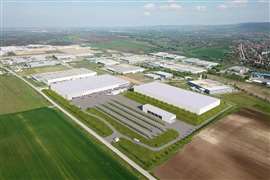Weight watchers
01 December 2016
Heavy lifting is changing as new technologies are developed and new applications are found. IC asked some of the largest companies in the sector to peep over the horizon and forecast future trends
AII the numbers surrounding the onshore heavy lifting sector are staggeringly large. As an example, the strongest crane in the world - the Taisun gantry crane, albeit confined to a yard in Shandong Province, China - can raise a breath-taking 20,000 tonnes, equivalent to 2,850 elephants, 167 blue whales, or two Eiffel Towers.
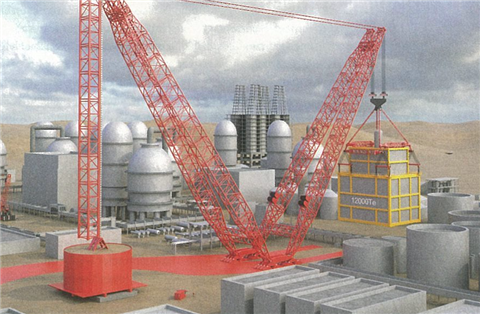 The Mammoet and Stoot 24,Q00 tonne capacity crane concept
The Mammoet and Stoot 24,Q00 tonne capacity crane concept
If its impressive 24,000 tonne capacity crane design ever escapes the drawing board, however, Mammoet will take the ultra-heavy lifting crown.
Proposed jointly by the Dutch lifting giant and Stoot Engineering and Innovation, also of the Netherlands, this monster will be called Focus and boast an remarkable maximum load moment rating of 1,500,000 tonne-metres.
Target applications include work in heavy industrial plants and refineries. Its ability to lift significantly bigger and heavier loads than currently possible will, says Mammoet, make projects far more efficient, in particular by reducing construction time, a primary aim on these projects with super heavy lifters.
Focus can be assembled vertically on a minimal ground area and without support cranes. It is designed to be self-erecting, even with a boom 200 metres long.
More from less
If it gets built, Focus will be well placed to tackle a paradox that lies at the heart of the heavy lifting sector - the pressing need to lift larger and heavier loads versus the relentless demand for smaller lifting systems that can operate in more confined spaces.
Enerpac claims to have solved this dilemma by developing multipoint, synchronised lifting systems such as its EVO-Series synchronous lifting systems, JS-Series jack-up systems and SHS - Series synchronous hoisting systems.
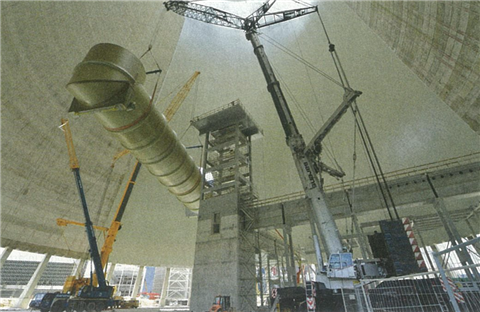 Sarens transported a 103 tonne, 50 metre long flue component with a diameter of 9.4 metres Inside the cooling tower at Elektrownla Opole power station in Poland
Sarens transported a 103 tonne, 50 metre long flue component with a diameter of 9.4 metres Inside the cooling tower at Elektrownla Opole power station in Poland
Yannick Sel, ALE senior sales manager - global projects division, agrees that size matters when it comes to working area: the more compact the better: “As ALE are increasingly working in smaller spaces, we are always looking for solutions to suit this set-up.”
For Sel, however, the biggest trend in the heavy lifting sector is an increase in the number of questions from customers about health, safety, quality and the environment, as well as maintenance: “Particularly in the nuclear industry, our clients are looking at the design of the crane - confirming it is safe and that we are maintaining it. They look at not just what equipment we are using, but also how we are mobilising and setting it up.”
Enerpac sees a trend towards modular construction methods which, it says, facilitates the need for specialized heavy lifting equipment. An example is accelerated bridge construction where the bridge is constructed off-site and then put in place.
This ‘prefabrication’ approach minimises traffic disruption, means a safer work environment and improves efficiency in bridge construction.
“In a similar way,” says the company, “we see modular construction of offshore platforms and power generation plants. For example, construction of a tension-leg platform for the Gulf of Mexico involved several modules weighing approximately 7,000 tonnes that needed to be slid into position. Enerpac strand jacks were used for loading out the utility, drilling and process modules, providing 1,500 tonnes of pulling force during the load-out procedure.”
Price is king
Yannick Sel sees an increasing number of heavy lift projects becoming price-driven at subcontractor level.
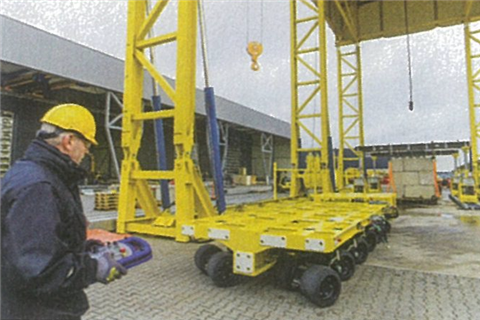 The Enerpac SPMTS00 self-propelled modular , transporter d1:,slgned for In-plant operation is controlled by a wireless controller
The Enerpac SPMTS00 self-propelled modular , transporter d1:,slgned for In-plant operation is controlled by a wireless controller
“Only by adding value with our expertise, global equipment fleet and bespoke engineering can we overcome this to continue the safety and quality of work within the heavy lifting industry,” he says.
Sarens, meanwhile, sees fewer new cranes being designed, but more crane auxiliaries and optimisation, “increasing the capacity of cranes without changing the base crane design allows for optimised engineering, more creativity, less space and lower price for similar lift with other higher capacity cranes. Flexibility and optimisation is what crane suppliers and clients love to see.”
The industry experts consulted for this feature broadly agreed on the main issues associated with planning a load sequence for a heavy lift. For Lampson, when planning for a heavy lift, the major categories that need to be considered are as follows:
■ Potential hazards to people.
■ Hazards in the proximity of the work area.
■ Complexity of the load handling activity.
■ Adverse impacts from environmental conditions.
■ Lift equipment and rigging capacity and-or performance.
■ Adverse commercial impact.
■ Site requirements unique to the load handling activity.
■ Federal, state and local safety requirements.
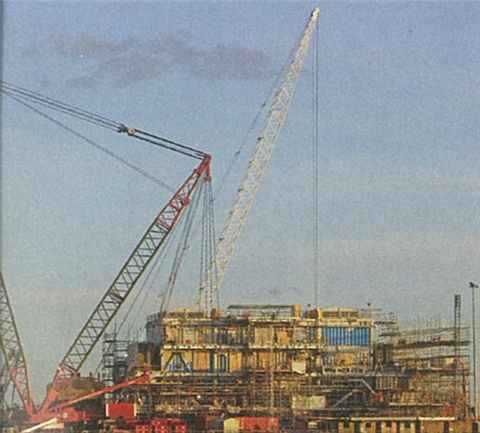 Specialist heavy lifting companies increasingly have to operate in congested areas with minimal space
Specialist heavy lifting companies increasingly have to operate in congested areas with minimal space
Kate Lampson adds, “These major categories will help determine if the lift is either standard or critical in nature, and each category has multiple related items ranging from determining accurate load information ... [to] verifying the allowable ground conditions, establishing a communication plan and controlling site access.”
Lampson relies on the ASME P30.1 Planning for Load Handling Activities Standard which helps identify the hazards and defines roles and responsibilities of persons involved in the planning and performance of the lift. Sarens has a similar heavy lift planning list:
■ Sales: well-defined scope and involving operations as soon as possible.
■ Handover sales ops: limiting loss of information.
■ Engineering - availability and quality of data (loads to be lifted - site - ground conditions - site specific engineering procedures and instructions).
■ Lifting plans not limited to drawings (include also method statements and task risk assessments).
■ Planning: many parameters, both internal and external, can have an impact on this.
■ Site regulations: site introductions - follow up on site.
■ Dedicated project management team - leadership skills.
■ Equipment condition - liability- reducing breakdown interventions on site.
■ Operators - attitude and experience.
■ Customer communication.
For Enerpac the main points to consider when developing a heavy lift system include site conditions and load geometry: “‘These can be completely different for a heavy lift conducted indoors versus outdoors, for example.
“Enerpac works closely with customers to ensure its lifting systems conform to site safety regulations. Ease of transportation is an area where Enerpac has taken a lead through its modular gantry, and bespoke handling systems shipped in multiple standard containers.”
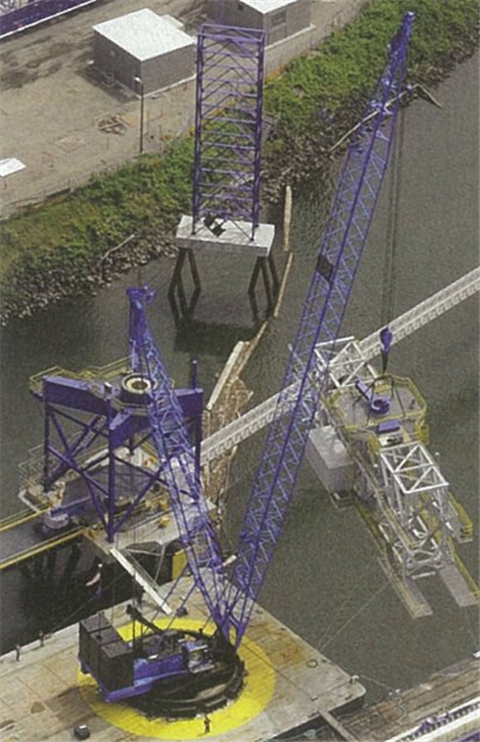 Lampson Advanced American 100 Ringer Series 3 crane offers 200 ton (181 tonne) capacity at a 60 foot (18 metre) radius
Lampson Advanced American 100 Ringer Series 3 crane offers 200 ton (181 tonne) capacity at a 60 foot (18 metre) radius
For ALE Yannick Sel says, “‘For us, the load sequence relies on the co-operation between us and the client’s delivery schedule, which we cannot control. However, by working closely and effectively, we can manage this alignment as best we can. Changing lifting arrangements can take time after each lift and if we use the same tackle, we can do a lift a day.”
Box Story: Latest Heavy Lifting Developments
ALE’s 5,000 tonne capacity AL.SK350 super heavy lift crane is being used for the first time in Brazil to lift and install approximately 40 modules weighing up to 3,000 tonnes onto the P-74 floating production, storage and offloading vessel (FPSO).
The AL.SK crane fleet can reach all lifting positions without relocating the crane or the hull. ALE is also at the final stages of fabricating a new heavy jib that can fit onto the AL.SK190 and AL.SK350 cranes that will lift 3,400 tonnes up to 100 metres off the ground.
The latest models added to the Lampson fleet are the Millennium 4100 crawler crane and the Lampson Transi-Lift LTL-3000. The Millennium 4100 can accept Manitowoc ring and tower attachments and tandem drum operation for endless reeving.
The LTL-3000 boasts hydraulic hoisting and an increased capacity exceeding 3,000 tonnes, Lampson said. The super heavy lift crane is also tested to Japanese Industrial Standards, to the European EN 13000 Standard and to US safety standards.
Sarens helped develop the Boom Booster for the 650 tonne capacity Demag CC 3800-1, previously called the SL3800, lattice boom crawler crane from Terex Cranes. The idea comes from the earlier development of a similar system for the larger CC 8800-1 crawler crane with Boom Booster, creating higher capacities at short radii.
In the highest range of ring type cranes, building on the company’s experience with its 120,000 tonne-metre SGC 120, is the Sarens SGC 250 which is on the drawing board. With a maximum load moment rating of 250,000 tonne-metres, this crane could be used in many applications, including the nuclear and FPSO construction sectors.


